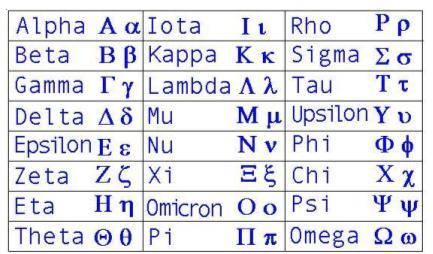Word of the Day
TAU (tou)
19th letter of the Greek alphabet
Common clues: Sigma follower; Frat name consonant; T in Sparta; T, to Theocritus
Crossword puzzle frequency: 8 times a year
Frequency in English language: 39892 / 86800
Video: Greek for the Street
The Greek alphabet is a set of 24 letters that has been used to write the Greek language since the late 9th or early 8th century BC. It was the first alphabet in the narrow sense, that is a writing system that uses a separate symbol for each vowel and consonant. It is the oldest alphabetic script in continuous use today. The letters were also used to represent Greek numerals, beginning in the 2nd century BC.
Courtesy
1728 Software Systems
ZETA (ZAY-tuh)
6th letter of the Greek alphabet
Common clues: Sixth Greek letter; Greek consonant
Crossword puzzle frequency: once a year
Frequency in English language: 19977 / 86800
The Greek alphabet is descended from the Phoenician alphabet, and unrelated to Linear B and the Cypriot syllabary, earlier writing systems for Greek. It has given rise to many other alphabets used in Europe and the Middle East, including the Latin alphabet.[2] In addition to being used for writing Modern Greek, its letters are today used as symbols in mathematics and science, particle names in physics, as names of stars, in the names of fraternities and sororities, in the naming of supernumerary tropical cyclones, and for other purposes.
ETA (AY-tuh)
7th letter of the Greek alphabet
Common clues: Greek "H"; Greek vowel; Letter from Athens; Hellenic vowel
Crossword puzzle frequency: 4 times a year
Frequency in English language: 16087 / 86800

Papyrus
fragment of Alcibiades by Plato
THETA (THAYE-tuh)
8th letter of the Greek alphabet
Common clues: Iota preceder; Eta follower; Eighth Greek letter; Fraternity letter
Crossword puzzle frequency: 3 times a year
Frequency in English language: 31737 / 86800
The Greek alphabet emerged several centuries after the fall of the Mycenaean civilization and consequent abandon of its Linear B script, an early Greek writing system. Linear B is descended from Linear A, which was developed by the Minoans, whose language was probably unrelated to Greek; consequently the Minoan syllabary did not provide an ideal medium for the transliteration of the sounds of the Greek language.
RHO (roh)
17th letter of the Greek alphabet
Common clues: Sigma preceder; Pi follower; Plato's P; Letter after pi; Frat house letter
Crossword puzzle frequency: 7 times a year
Frequency in English language: 55452 / 86800
The Greek alphabet we recognize today arose after the Greek Dark Ages — the period between the downfall of Mycenae (ca. 1200 BC) and the rise of Ancient Greece, which begins with the appearance of the epics of Homer, around 800 BC, and the institution of the Ancient Olympic Games in 776 BC. Its most notable change, as an adaptation of the Phoenician alphabet, is the introduction of vowel letters: without which Greek would be illegible.
SIGMA (SIG-muh)
18th letter of the Greek alphabet
Common clues: Greek letter; 18th letter of the Greek alphabet; Frat letter
Crossword puzzle frequency: once a year
Frequency in English language: 17403 / 86800
Vowel signs were originally not used in Semitic alphabets. Whereas in the earlier West Semitic family of scripts (Phoenician, Hebrew, Moabite etc.) a letter always stood for a consonant in association with an unspecified vowel or no vowel, the Greek alphabet divided the letters into two categories, consonants ("things that sound along") and vowels, where the consonant letters always had to be accompanied by vowels to create a pronounceable unit. Although the old Ugaritic alphabet did develop matres lectionis, i.e. consonant letters were used to denote vowels, they were never employed systematically.
PHI (feye)
21st letter of Greek alphabet
Common clues: Greek letter; Frat letter; 21st Greek letter; ___ Beta Kappa; Follower of Upsilon
Crossword puzzle frequency: 2 times a year
Frequency in English language: 42011 / 86800
CHI (kee)
22nd letter of the Greek alphabet
Common clues: Phi follower; Frat letter; Third to last Greek letter; Greek “X”
Crossword puzzle frequency: 3 times a year
Frequency in English language: 16824 / 86800
PSI (sigh)
23rd letter of the Greek alphabet
Common clues: Chi-omega go-between; 23rd Greek letter; Trident-shaped letter
Crossword puzzle frequency: 7 times a year
Frequency in English language: 24433 / 86800
This article is licensed under the GNU Free Documentation License. It uses material from the Wikipedia article "Greek alphabet".
|
|
